Business Research: Social Media in the Australian Food Industry
VerifiedAdded on 2020/04/13
|11
|2821
|45
Report
AI Summary
This research report examines the advantages and disadvantages of utilizing social media in the Australian food business sector. It begins with an introduction highlighting the increasing importance of social media for business growth, particularly in reaching target customers and facilitating communication. The report outlines project objectives and scope, followed by a literature review that explores the impact of social media marketing, customer engagement, and the evolution of online platforms. The methodology section details both qualitative and quantitative research approaches, including survey methods and data analysis. The research identifies several advantages, such as cost reduction, enhanced customer connection, and effective brand promotion, while also acknowledging potential disadvantages like trademark issues and privacy concerns. The report includes a detailed time schedule and concludes by emphasizing the significance of social media for modern marketing, while recommending that businesses conduct thorough research before integrating social media strategies. References and an appendix with a time schedule are also provided.
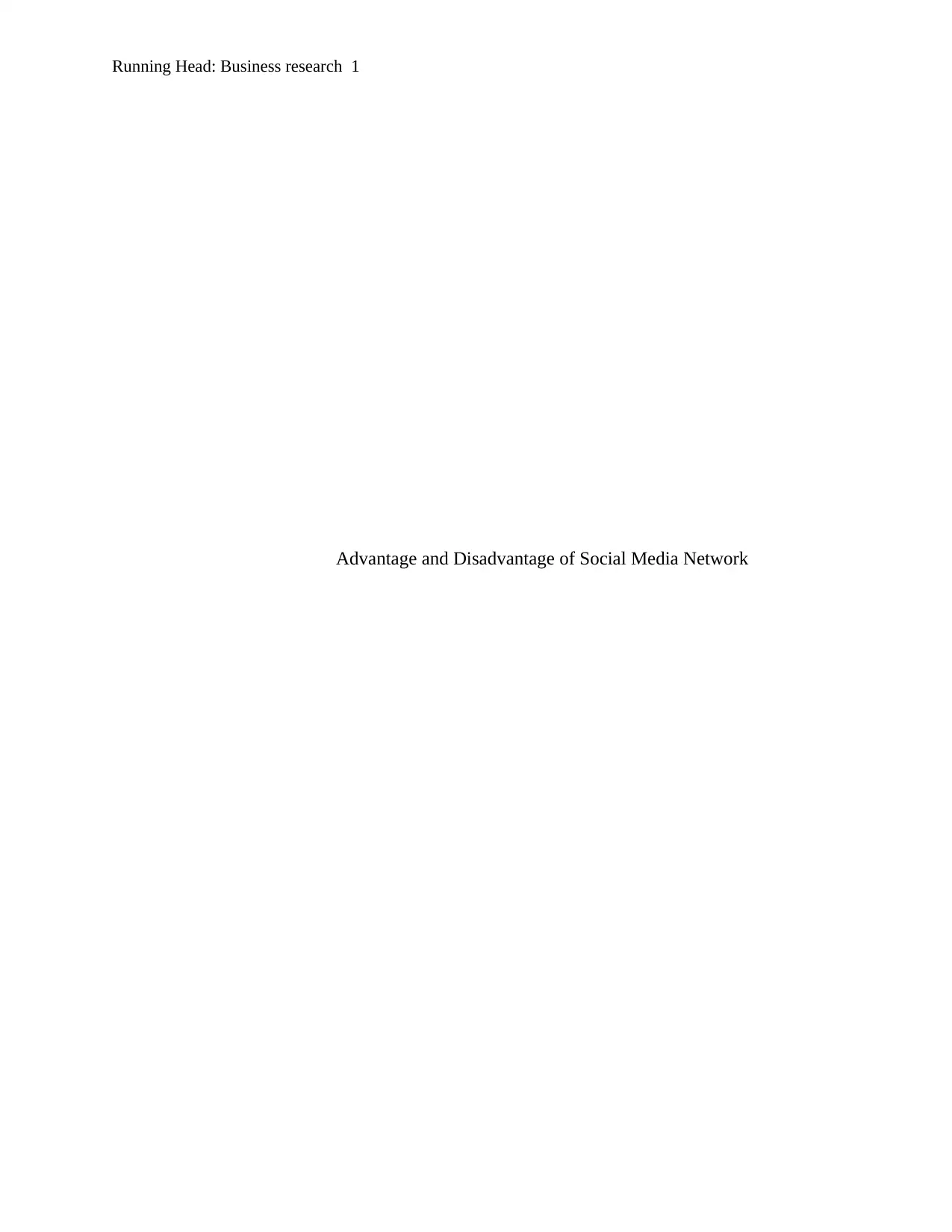
Running Head: Business research 1
Advantage and Disadvantage of Social Media Network
Advantage and Disadvantage of Social Media Network
Paraphrase This Document
Need a fresh take? Get an instant paraphrase of this document with our AI Paraphraser
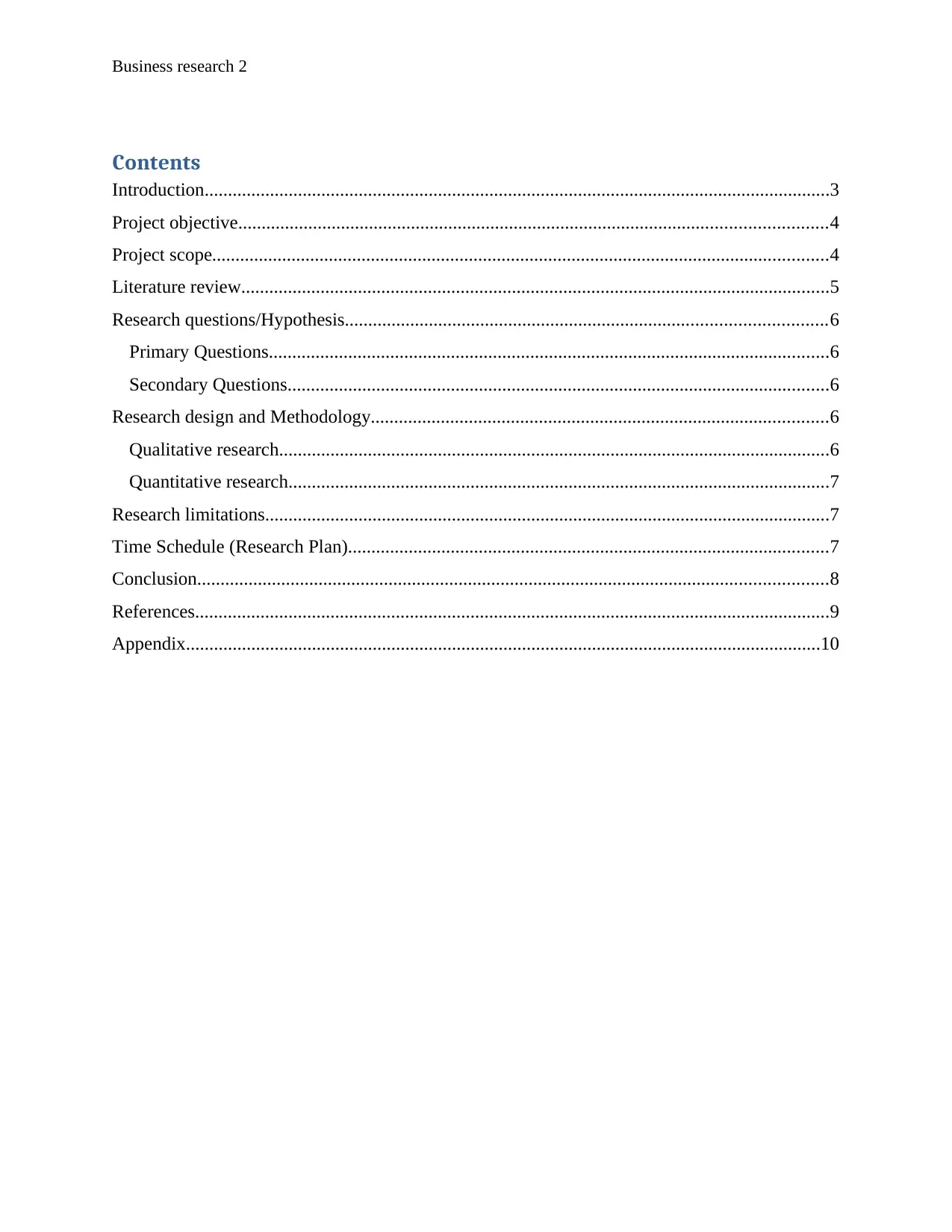
Business research 2
Contents
Introduction......................................................................................................................................3
Project objective..............................................................................................................................4
Project scope....................................................................................................................................4
Literature review..............................................................................................................................5
Research questions/Hypothesis.......................................................................................................6
Primary Questions........................................................................................................................6
Secondary Questions....................................................................................................................6
Research design and Methodology..................................................................................................6
Qualitative research......................................................................................................................6
Quantitative research....................................................................................................................7
Research limitations.........................................................................................................................7
Time Schedule (Research Plan).......................................................................................................7
Conclusion.......................................................................................................................................8
References........................................................................................................................................9
Appendix........................................................................................................................................10
Contents
Introduction......................................................................................................................................3
Project objective..............................................................................................................................4
Project scope....................................................................................................................................4
Literature review..............................................................................................................................5
Research questions/Hypothesis.......................................................................................................6
Primary Questions........................................................................................................................6
Secondary Questions....................................................................................................................6
Research design and Methodology..................................................................................................6
Qualitative research......................................................................................................................6
Quantitative research....................................................................................................................7
Research limitations.........................................................................................................................7
Time Schedule (Research Plan).......................................................................................................7
Conclusion.......................................................................................................................................8
References........................................................................................................................................9
Appendix........................................................................................................................................10

Business research 3
Introduction
This research is conducted to analyze the advantage and disadvantage of using social
media in the food business in Australia. Social media has played an important role in the success
and growth of a company. To stay competitive in the market, it is important for the companies to
identify the target customers to expand the business in the social networking sites. In the recent
decades, social media is an important concept by which companies are getting opportunities to
expand the business by business-to-customer, business-to-business communication, and
customer-to customer communication (Weiss, Lurie & Macinnis, 2008).
The key objective of this analysis is to understand the pros and cons of social media in
the business. Social media has provided various opportunities to the food sector to present the
products in different communities that may be involved. Social media includes various functions
in the form of technology which allows the companies to tag, blog, post and dig etc. There are
various social media platforms such as MySpace, Digg, FaceBook, Twitter, LinkedIn and
Google Plus etc. All these platforms are helpful for the businesses like food business in order to
provide the information related to the products and services. Social media is now considered as
an effective tool for various organizations to market their products and services. Further, it is
observed that the social media users are highly motivated with their buying decisions. Along
with this, 70% of users are engaged in social media marketing and it has unenthusiastic impact
on the marketers also. Despite of advantages, there are some disadvantages involved in social
media which need to be addressed effectively (Hill & Moran, 2011).
While dealing with the social networking platforms in the business of food industry, the
companies have to face challenge related to the lack of budget. It is well known that the social
networking sites play a crucial role in the business operations as they are able to connect with the
people in the operating market. There are some advantages of social media in the business
perspective (Forman, Ghose & Wiesenfeld, 2008).
Social media includes various platforms dealing in the different way and they have
various advanced features for the additional fee. Some of the social media sites have
features that are free to use.
Introduction
This research is conducted to analyze the advantage and disadvantage of using social
media in the food business in Australia. Social media has played an important role in the success
and growth of a company. To stay competitive in the market, it is important for the companies to
identify the target customers to expand the business in the social networking sites. In the recent
decades, social media is an important concept by which companies are getting opportunities to
expand the business by business-to-customer, business-to-business communication, and
customer-to customer communication (Weiss, Lurie & Macinnis, 2008).
The key objective of this analysis is to understand the pros and cons of social media in
the business. Social media has provided various opportunities to the food sector to present the
products in different communities that may be involved. Social media includes various functions
in the form of technology which allows the companies to tag, blog, post and dig etc. There are
various social media platforms such as MySpace, Digg, FaceBook, Twitter, LinkedIn and
Google Plus etc. All these platforms are helpful for the businesses like food business in order to
provide the information related to the products and services. Social media is now considered as
an effective tool for various organizations to market their products and services. Further, it is
observed that the social media users are highly motivated with their buying decisions. Along
with this, 70% of users are engaged in social media marketing and it has unenthusiastic impact
on the marketers also. Despite of advantages, there are some disadvantages involved in social
media which need to be addressed effectively (Hill & Moran, 2011).
While dealing with the social networking platforms in the business of food industry, the
companies have to face challenge related to the lack of budget. It is well known that the social
networking sites play a crucial role in the business operations as they are able to connect with the
people in the operating market. There are some advantages of social media in the business
perspective (Forman, Ghose & Wiesenfeld, 2008).
Social media includes various platforms dealing in the different way and they have
various advanced features for the additional fee. Some of the social media sites have
features that are free to use.
⊘ This is a preview!⊘
Do you want full access?
Subscribe today to unlock all pages.

Trusted by 1+ million students worldwide
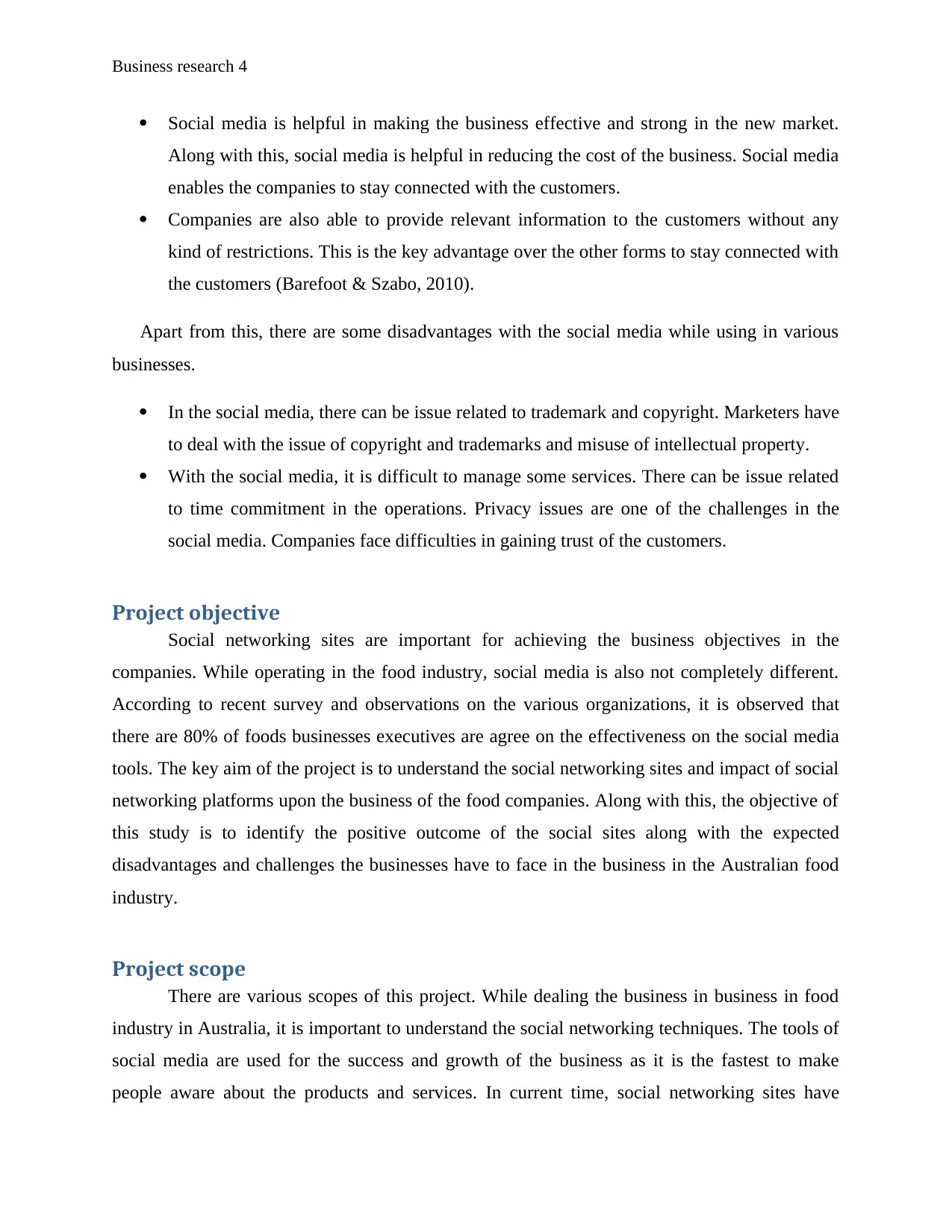
Business research 4
Social media is helpful in making the business effective and strong in the new market.
Along with this, social media is helpful in reducing the cost of the business. Social media
enables the companies to stay connected with the customers.
Companies are also able to provide relevant information to the customers without any
kind of restrictions. This is the key advantage over the other forms to stay connected with
the customers (Barefoot & Szabo, 2010).
Apart from this, there are some disadvantages with the social media while using in various
businesses.
In the social media, there can be issue related to trademark and copyright. Marketers have
to deal with the issue of copyright and trademarks and misuse of intellectual property.
With the social media, it is difficult to manage some services. There can be issue related
to time commitment in the operations. Privacy issues are one of the challenges in the
social media. Companies face difficulties in gaining trust of the customers.
Project objective
Social networking sites are important for achieving the business objectives in the
companies. While operating in the food industry, social media is also not completely different.
According to recent survey and observations on the various organizations, it is observed that
there are 80% of foods businesses executives are agree on the effectiveness on the social media
tools. The key aim of the project is to understand the social networking sites and impact of social
networking platforms upon the business of the food companies. Along with this, the objective of
this study is to identify the positive outcome of the social sites along with the expected
disadvantages and challenges the businesses have to face in the business in the Australian food
industry.
Project scope
There are various scopes of this project. While dealing the business in business in food
industry in Australia, it is important to understand the social networking techniques. The tools of
social media are used for the success and growth of the business as it is the fastest to make
people aware about the products and services. In current time, social networking sites have
Social media is helpful in making the business effective and strong in the new market.
Along with this, social media is helpful in reducing the cost of the business. Social media
enables the companies to stay connected with the customers.
Companies are also able to provide relevant information to the customers without any
kind of restrictions. This is the key advantage over the other forms to stay connected with
the customers (Barefoot & Szabo, 2010).
Apart from this, there are some disadvantages with the social media while using in various
businesses.
In the social media, there can be issue related to trademark and copyright. Marketers have
to deal with the issue of copyright and trademarks and misuse of intellectual property.
With the social media, it is difficult to manage some services. There can be issue related
to time commitment in the operations. Privacy issues are one of the challenges in the
social media. Companies face difficulties in gaining trust of the customers.
Project objective
Social networking sites are important for achieving the business objectives in the
companies. While operating in the food industry, social media is also not completely different.
According to recent survey and observations on the various organizations, it is observed that
there are 80% of foods businesses executives are agree on the effectiveness on the social media
tools. The key aim of the project is to understand the social networking sites and impact of social
networking platforms upon the business of the food companies. Along with this, the objective of
this study is to identify the positive outcome of the social sites along with the expected
disadvantages and challenges the businesses have to face in the business in the Australian food
industry.
Project scope
There are various scopes of this project. While dealing the business in business in food
industry in Australia, it is important to understand the social networking techniques. The tools of
social media are used for the success and growth of the business as it is the fastest to make
people aware about the products and services. In current time, social networking sites have
Paraphrase This Document
Need a fresh take? Get an instant paraphrase of this document with our AI Paraphraser
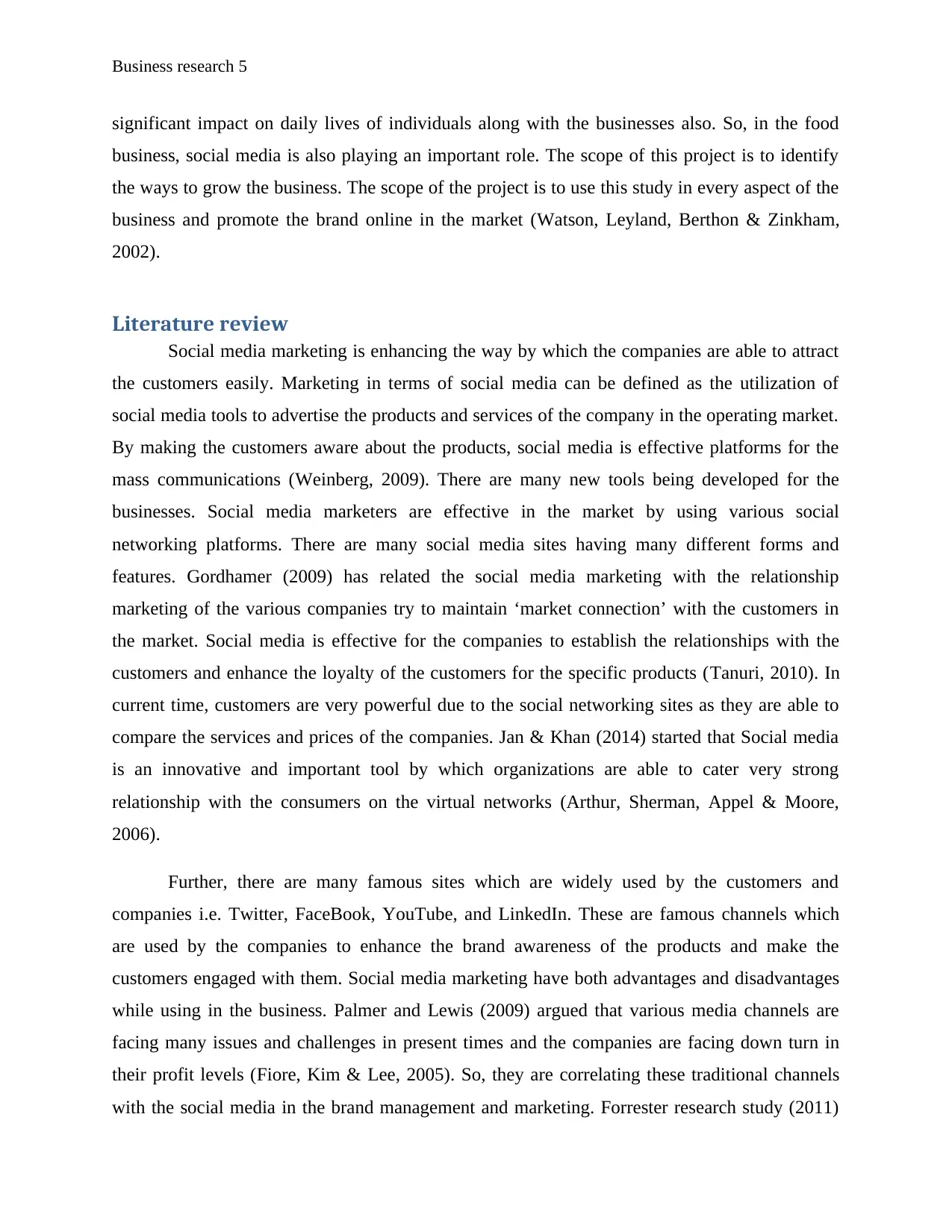
Business research 5
significant impact on daily lives of individuals along with the businesses also. So, in the food
business, social media is also playing an important role. The scope of this project is to identify
the ways to grow the business. The scope of the project is to use this study in every aspect of the
business and promote the brand online in the market (Watson, Leyland, Berthon & Zinkham,
2002).
Literature review
Social media marketing is enhancing the way by which the companies are able to attract
the customers easily. Marketing in terms of social media can be defined as the utilization of
social media tools to advertise the products and services of the company in the operating market.
By making the customers aware about the products, social media is effective platforms for the
mass communications (Weinberg, 2009). There are many new tools being developed for the
businesses. Social media marketers are effective in the market by using various social
networking platforms. There are many social media sites having many different forms and
features. Gordhamer (2009) has related the social media marketing with the relationship
marketing of the various companies try to maintain ‘market connection’ with the customers in
the market. Social media is effective for the companies to establish the relationships with the
customers and enhance the loyalty of the customers for the specific products (Tanuri, 2010). In
current time, customers are very powerful due to the social networking sites as they are able to
compare the services and prices of the companies. Jan & Khan (2014) started that Social media
is an innovative and important tool by which organizations are able to cater very strong
relationship with the consumers on the virtual networks (Arthur, Sherman, Appel & Moore,
2006).
Further, there are many famous sites which are widely used by the customers and
companies i.e. Twitter, FaceBook, YouTube, and LinkedIn. These are famous channels which
are used by the companies to enhance the brand awareness of the products and make the
customers engaged with them. Social media marketing have both advantages and disadvantages
while using in the business. Palmer and Lewis (2009) argued that various media channels are
facing many issues and challenges in present times and the companies are facing down turn in
their profit levels (Fiore, Kim & Lee, 2005). So, they are correlating these traditional channels
with the social media in the brand management and marketing. Forrester research study (2011)
significant impact on daily lives of individuals along with the businesses also. So, in the food
business, social media is also playing an important role. The scope of this project is to identify
the ways to grow the business. The scope of the project is to use this study in every aspect of the
business and promote the brand online in the market (Watson, Leyland, Berthon & Zinkham,
2002).
Literature review
Social media marketing is enhancing the way by which the companies are able to attract
the customers easily. Marketing in terms of social media can be defined as the utilization of
social media tools to advertise the products and services of the company in the operating market.
By making the customers aware about the products, social media is effective platforms for the
mass communications (Weinberg, 2009). There are many new tools being developed for the
businesses. Social media marketers are effective in the market by using various social
networking platforms. There are many social media sites having many different forms and
features. Gordhamer (2009) has related the social media marketing with the relationship
marketing of the various companies try to maintain ‘market connection’ with the customers in
the market. Social media is effective for the companies to establish the relationships with the
customers and enhance the loyalty of the customers for the specific products (Tanuri, 2010). In
current time, customers are very powerful due to the social networking sites as they are able to
compare the services and prices of the companies. Jan & Khan (2014) started that Social media
is an innovative and important tool by which organizations are able to cater very strong
relationship with the consumers on the virtual networks (Arthur, Sherman, Appel & Moore,
2006).
Further, there are many famous sites which are widely used by the customers and
companies i.e. Twitter, FaceBook, YouTube, and LinkedIn. These are famous channels which
are used by the companies to enhance the brand awareness of the products and make the
customers engaged with them. Social media marketing have both advantages and disadvantages
while using in the business. Palmer and Lewis (2009) argued that various media channels are
facing many issues and challenges in present times and the companies are facing down turn in
their profit levels (Fiore, Kim & Lee, 2005). So, they are correlating these traditional channels
with the social media in the brand management and marketing. Forrester research study (2011)
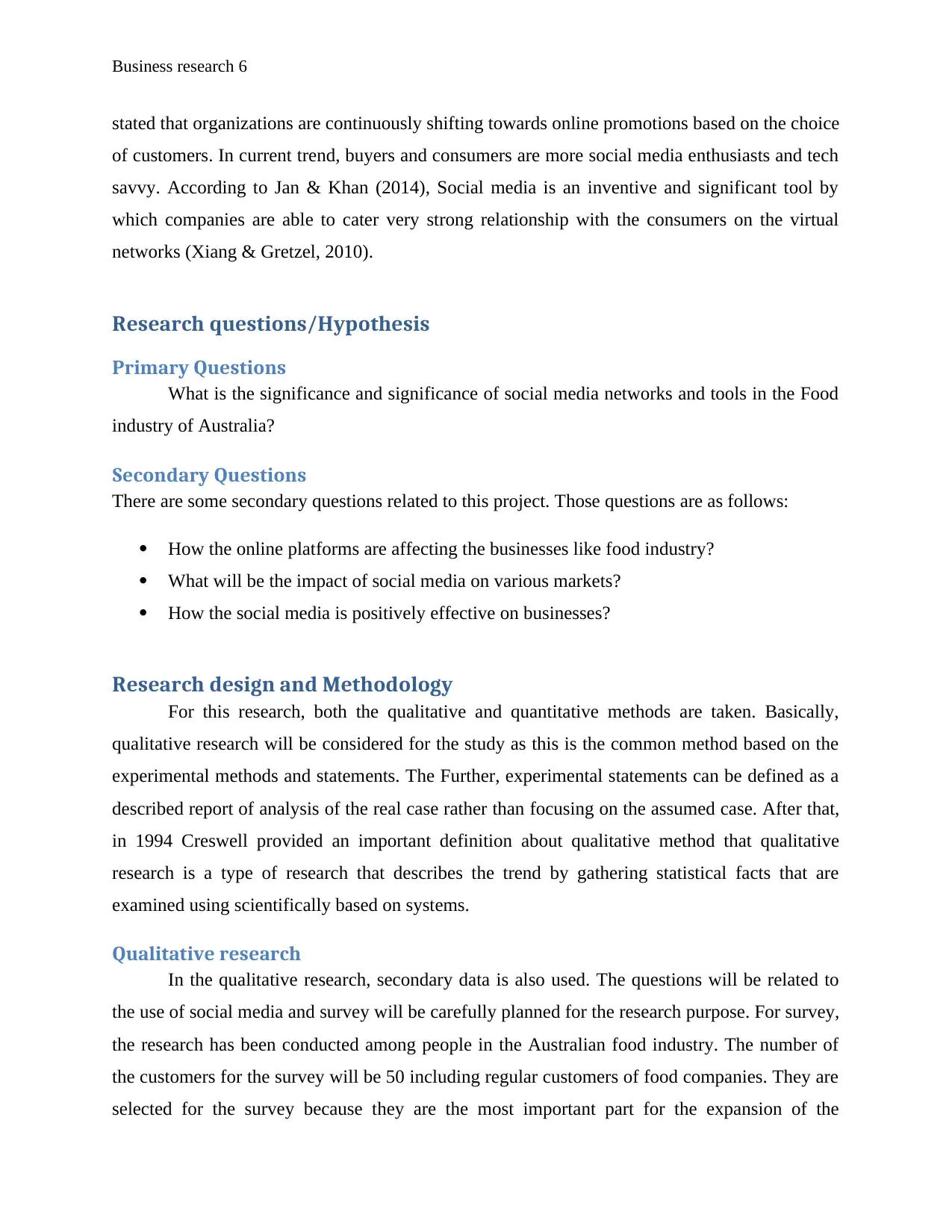
Business research 6
stated that organizations are continuously shifting towards online promotions based on the choice
of customers. In current trend, buyers and consumers are more social media enthusiasts and tech
savvy. According to Jan & Khan (2014), Social media is an inventive and significant tool by
which companies are able to cater very strong relationship with the consumers on the virtual
networks (Xiang & Gretzel, 2010).
Research questions/Hypothesis
Primary Questions
What is the significance and significance of social media networks and tools in the Food
industry of Australia?
Secondary Questions
There are some secondary questions related to this project. Those questions are as follows:
How the online platforms are affecting the businesses like food industry?
What will be the impact of social media on various markets?
How the social media is positively effective on businesses?
Research design and Methodology
For this research, both the qualitative and quantitative methods are taken. Basically,
qualitative research will be considered for the study as this is the common method based on the
experimental methods and statements. The Further, experimental statements can be defined as a
described report of analysis of the real case rather than focusing on the assumed case. After that,
in 1994 Creswell provided an important definition about qualitative method that qualitative
research is a type of research that describes the trend by gathering statistical facts that are
examined using scientifically based on systems.
Qualitative research
In the qualitative research, secondary data is also used. The questions will be related to
the use of social media and survey will be carefully planned for the research purpose. For survey,
the research has been conducted among people in the Australian food industry. The number of
the customers for the survey will be 50 including regular customers of food companies. They are
selected for the survey because they are the most important part for the expansion of the
stated that organizations are continuously shifting towards online promotions based on the choice
of customers. In current trend, buyers and consumers are more social media enthusiasts and tech
savvy. According to Jan & Khan (2014), Social media is an inventive and significant tool by
which companies are able to cater very strong relationship with the consumers on the virtual
networks (Xiang & Gretzel, 2010).
Research questions/Hypothesis
Primary Questions
What is the significance and significance of social media networks and tools in the Food
industry of Australia?
Secondary Questions
There are some secondary questions related to this project. Those questions are as follows:
How the online platforms are affecting the businesses like food industry?
What will be the impact of social media on various markets?
How the social media is positively effective on businesses?
Research design and Methodology
For this research, both the qualitative and quantitative methods are taken. Basically,
qualitative research will be considered for the study as this is the common method based on the
experimental methods and statements. The Further, experimental statements can be defined as a
described report of analysis of the real case rather than focusing on the assumed case. After that,
in 1994 Creswell provided an important definition about qualitative method that qualitative
research is a type of research that describes the trend by gathering statistical facts that are
examined using scientifically based on systems.
Qualitative research
In the qualitative research, secondary data is also used. The questions will be related to
the use of social media and survey will be carefully planned for the research purpose. For survey,
the research has been conducted among people in the Australian food industry. The number of
the customers for the survey will be 50 including regular customers of food companies. They are
selected for the survey because they are the most important part for the expansion of the
⊘ This is a preview!⊘
Do you want full access?
Subscribe today to unlock all pages.

Trusted by 1+ million students worldwide

Business research 7
business. They can be more trustworthy in conditions of research. They are the most important
part of the survey because by the client’s review, their needs can be identified.
Most of the questions have several choices with 5 options and also there are some open
questions where answer will be given in their own words by the customers. The questionnaire
has been sent on their email addresses. For secondary data, evaluations and study of other
authors will be taken. So, the theory will be partially based on the references and strategy of
other authors (Gurau, 2008).
Quantitative research
The quantitative research will be done based on the numeric data and facts related to the
growth of the food industry. The result will be based on the values and figures by which the
research objectives and result related to use of social media in the food industry will be analyzed.
The quantitative research will be helpful to understand the strengths and weaknesses of the
companies in the food industry. Quantitative research is helpful in resolving the challenges
associated in the business to achieve the goals and objectives.
Research limitations
The key limitation of this research is that the research is only based on the perspective of
the consumers and secondary data analysis of the literature review. Because of less primary data
of the food business, this study may not be able to provide quantifiable results related to the
effectiveness of social media over the traditional marketing methods in the industry.
Time Schedule (Research Plan)
Activities Lead Time Time Spend Time Cushion
Collecting
information
6 days 1st Nov -6th Nov 2 days
Organizing
Information
3 days 7th Nov – 10th Nov 1 day
business. They can be more trustworthy in conditions of research. They are the most important
part of the survey because by the client’s review, their needs can be identified.
Most of the questions have several choices with 5 options and also there are some open
questions where answer will be given in their own words by the customers. The questionnaire
has been sent on their email addresses. For secondary data, evaluations and study of other
authors will be taken. So, the theory will be partially based on the references and strategy of
other authors (Gurau, 2008).
Quantitative research
The quantitative research will be done based on the numeric data and facts related to the
growth of the food industry. The result will be based on the values and figures by which the
research objectives and result related to use of social media in the food industry will be analyzed.
The quantitative research will be helpful to understand the strengths and weaknesses of the
companies in the food industry. Quantitative research is helpful in resolving the challenges
associated in the business to achieve the goals and objectives.
Research limitations
The key limitation of this research is that the research is only based on the perspective of
the consumers and secondary data analysis of the literature review. Because of less primary data
of the food business, this study may not be able to provide quantifiable results related to the
effectiveness of social media over the traditional marketing methods in the industry.
Time Schedule (Research Plan)
Activities Lead Time Time Spend Time Cushion
Collecting
information
6 days 1st Nov -6th Nov 2 days
Organizing
Information
3 days 7th Nov – 10th Nov 1 day
Paraphrase This Document
Need a fresh take? Get an instant paraphrase of this document with our AI Paraphraser

Business research 8
Completing primary
information phase
2 days 11th Nov -13th Nov 2 days
Conducting survey 5 days 15th Nov– 20th Nov 1days
Analysis of
information
1 day 21st Nov -22nd Nov 1 day
Conclude research 2 days 23rd Nov – 25th Nov 1day
Writing report 1 days 26th Nov 3 days
Draft review 1 days 27th Nov 4 days
Change Revision of
draft
1 day 28th Nov 1 day
Review 1 days 29th Nov 1 day
Finalizing report 1 day 30th Nov 1 day
Submission approval 1 days 1st of Dec 1 day
Conclusion
Social media is a significant platform by which marketers and advertisers are able to
converse with the customers and buyers. In present time, customers are experiencing a new
phase of social media. The tools of social media are efficient in developing and creating pictures
and videos of the products. Based on the above discussion, it is analyzed that there are both
advantages and disadvantages of social media tools while using in the business operations.
Numerous corporations are still struggling to discover correct method to use social media. Still,
many marketers are not fully aware of risk and challenges associated with social media
marketing. So, before using social media in business, companies have to do full study on the
social media practices. A company must identify essential values and plans of using social media
in the business practices. Main aim of the company must be to encourage, increase loyalty and
provide good quality products and services to satisfy the requirements of the customers.
Completing primary
information phase
2 days 11th Nov -13th Nov 2 days
Conducting survey 5 days 15th Nov– 20th Nov 1days
Analysis of
information
1 day 21st Nov -22nd Nov 1 day
Conclude research 2 days 23rd Nov – 25th Nov 1day
Writing report 1 days 26th Nov 3 days
Draft review 1 days 27th Nov 4 days
Change Revision of
draft
1 day 28th Nov 1 day
Review 1 days 29th Nov 1 day
Finalizing report 1 day 30th Nov 1 day
Submission approval 1 days 1st of Dec 1 day
Conclusion
Social media is a significant platform by which marketers and advertisers are able to
converse with the customers and buyers. In present time, customers are experiencing a new
phase of social media. The tools of social media are efficient in developing and creating pictures
and videos of the products. Based on the above discussion, it is analyzed that there are both
advantages and disadvantages of social media tools while using in the business operations.
Numerous corporations are still struggling to discover correct method to use social media. Still,
many marketers are not fully aware of risk and challenges associated with social media
marketing. So, before using social media in business, companies have to do full study on the
social media practices. A company must identify essential values and plans of using social media
in the business practices. Main aim of the company must be to encourage, increase loyalty and
provide good quality products and services to satisfy the requirements of the customers.
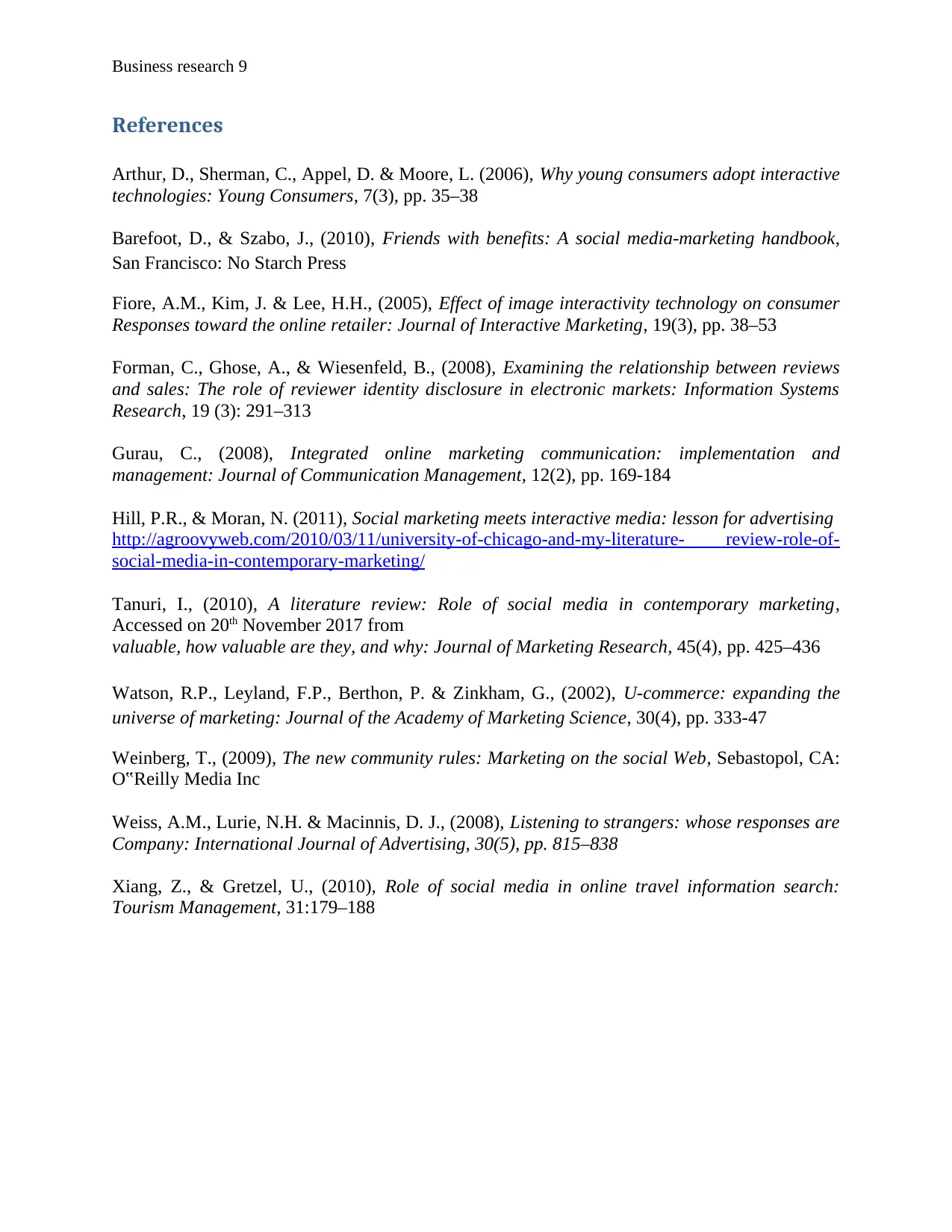
Business research 9
References
Arthur, D., Sherman, C., Appel, D. & Moore, L. (2006), Why young consumers adopt interactive
technologies: Young Consumers, 7(3), pp. 35–38
Barefoot, D., & Szabo, J., (2010), Friends with benefits: A social media-marketing handbook,
San Francisco: No Starch Press
Fiore, A.M., Kim, J. & Lee, H.H., (2005), Effect of image interactivity technology on consumer
Responses toward the online retailer: Journal of Interactive Marketing, 19(3), pp. 38–53
Forman, C., Ghose, A., & Wiesenfeld, B., (2008), Examining the relationship between reviews
and sales: The role of reviewer identity disclosure in electronic markets: Information Systems
Research, 19 (3): 291–313
Gurau, C., (2008), Integrated online marketing communication: implementation and
management: Journal of Communication Management, 12(2), pp. 169-184
Hill, P.R., & Moran, N. (2011), Social marketing meets interactive media: lesson for advertising
http://agroovyweb.com/2010/03/11/university-of-chicago-and-my-literature- review-role-of-
social-media-in-contemporary-marketing/
Tanuri, I., (2010), A literature review: Role of social media in contemporary marketing,
Accessed on 20th November 2017 from
valuable, how valuable are they, and why: Journal of Marketing Research, 45(4), pp. 425–436
Watson, R.P., Leyland, F.P., Berthon, P. & Zinkham, G., (2002), U-commerce: expanding the
universe of marketing: Journal of the Academy of Marketing Science, 30(4), pp. 333-47
Weinberg, T., (2009), The new community rules: Marketing on the social Web, Sebastopol, CA:
O‟Reilly Media Inc
Weiss, A.M., Lurie, N.H. & Macinnis, D. J., (2008), Listening to strangers: whose responses are
Company: International Journal of Advertising, 30(5), pp. 815–838
Xiang, Z., & Gretzel, U., (2010), Role of social media in online travel information search:
Tourism Management, 31:179–188
References
Arthur, D., Sherman, C., Appel, D. & Moore, L. (2006), Why young consumers adopt interactive
technologies: Young Consumers, 7(3), pp. 35–38
Barefoot, D., & Szabo, J., (2010), Friends with benefits: A social media-marketing handbook,
San Francisco: No Starch Press
Fiore, A.M., Kim, J. & Lee, H.H., (2005), Effect of image interactivity technology on consumer
Responses toward the online retailer: Journal of Interactive Marketing, 19(3), pp. 38–53
Forman, C., Ghose, A., & Wiesenfeld, B., (2008), Examining the relationship between reviews
and sales: The role of reviewer identity disclosure in electronic markets: Information Systems
Research, 19 (3): 291–313
Gurau, C., (2008), Integrated online marketing communication: implementation and
management: Journal of Communication Management, 12(2), pp. 169-184
Hill, P.R., & Moran, N. (2011), Social marketing meets interactive media: lesson for advertising
http://agroovyweb.com/2010/03/11/university-of-chicago-and-my-literature- review-role-of-
social-media-in-contemporary-marketing/
Tanuri, I., (2010), A literature review: Role of social media in contemporary marketing,
Accessed on 20th November 2017 from
valuable, how valuable are they, and why: Journal of Marketing Research, 45(4), pp. 425–436
Watson, R.P., Leyland, F.P., Berthon, P. & Zinkham, G., (2002), U-commerce: expanding the
universe of marketing: Journal of the Academy of Marketing Science, 30(4), pp. 333-47
Weinberg, T., (2009), The new community rules: Marketing on the social Web, Sebastopol, CA:
O‟Reilly Media Inc
Weiss, A.M., Lurie, N.H. & Macinnis, D. J., (2008), Listening to strangers: whose responses are
Company: International Journal of Advertising, 30(5), pp. 815–838
Xiang, Z., & Gretzel, U., (2010), Role of social media in online travel information search:
Tourism Management, 31:179–188
⊘ This is a preview!⊘
Do you want full access?
Subscribe today to unlock all pages.

Trusted by 1+ million students worldwide

Business research 10
Appendix
Survey Questions:
Q1. For how long you use the social media sites?
Q2. How much social media services are helpful for you?
Q3. How would you rate various social media tools based on services?
a) Highly satisfied
b) Satisfied
c) Neutral
d) Dissatisfied
e) Highly dissatisfied
Q4.How much you are satisfied with the services various social media tools?
a) Highly satisfied
b) Satisfied
c) Neutral
d) Dissatisfied
e) Highly dissatisfied
Q5. Do you agree that social media platforms are available anywhere?
a) Highly agreed
b) Agreed
c) Neutral
d) Disagreed
e) Highly disagreed
Q6. Do you feel that there are sufficient workers for the service?
Appendix
Survey Questions:
Q1. For how long you use the social media sites?
Q2. How much social media services are helpful for you?
Q3. How would you rate various social media tools based on services?
a) Highly satisfied
b) Satisfied
c) Neutral
d) Dissatisfied
e) Highly dissatisfied
Q4.How much you are satisfied with the services various social media tools?
a) Highly satisfied
b) Satisfied
c) Neutral
d) Dissatisfied
e) Highly dissatisfied
Q5. Do you agree that social media platforms are available anywhere?
a) Highly agreed
b) Agreed
c) Neutral
d) Disagreed
e) Highly disagreed
Q6. Do you feel that there are sufficient workers for the service?
Paraphrase This Document
Need a fresh take? Get an instant paraphrase of this document with our AI Paraphraser

Business research 11
a) Highly agreed
b) Agreed
c) Neutral
d) Disagreed
e) Highly disagreed
Q7. Would you recommend social media sites to various businesses?
a) Yes
b) No
Q8. What are the suggestions according to you that food industry should adopt social
media sites for the business expansions?
Q9. Does the food companies provide services on social media sites?
a) Highly agreed
b) Agreed
c) Neutral
d) Disagreed
e) Highly disagreed
Q10. Do you have any suggestion for improvement while using social media sites?
a) Highly agreed
b) Agreed
c) Neutral
d) Disagreed
e) Highly disagreed
Q7. Would you recommend social media sites to various businesses?
a) Yes
b) No
Q8. What are the suggestions according to you that food industry should adopt social
media sites for the business expansions?
Q9. Does the food companies provide services on social media sites?
a) Highly agreed
b) Agreed
c) Neutral
d) Disagreed
e) Highly disagreed
Q10. Do you have any suggestion for improvement while using social media sites?
1 out of 11
Related Documents
Your All-in-One AI-Powered Toolkit for Academic Success.
+13062052269
info@desklib.com
Available 24*7 on WhatsApp / Email
![[object Object]](/_next/static/media/star-bottom.7253800d.svg)
Unlock your academic potential
Copyright © 2020–2025 A2Z Services. All Rights Reserved. Developed and managed by ZUCOL.




